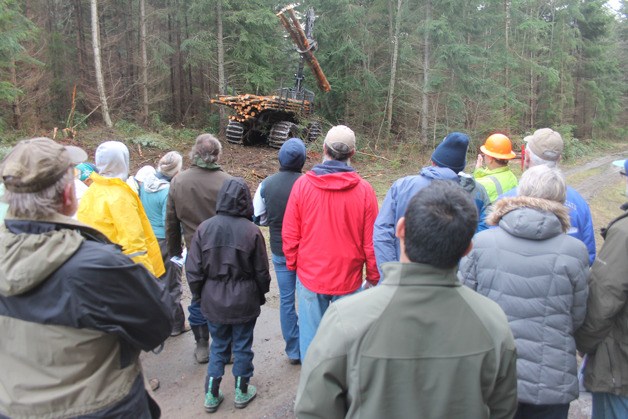The crunch and crack of trees being felled and cleared echoed through the chilly, wet air of the Trillium Woods on Friday morning.
About 20 people donned boots to traipse through a section of the Freeland forest’s 654 acres as part of a tour to see how the Whidbey Camano Land Trust manages the land. Led by Mike Janicki, owner of Janicki Logging & Construction which was brought in to “thin” the woods, the visitors asked about the practice of selecting trees for thinning, reflected on the property’s history and pondered its future.
During the current operation, Janicki said they were working on 130 acres and would take about one-third of the trees in the area. Most of the trees were headed to pulp mills, as they were too young and small to be made into lumber. Forest health was at stake, said Janicki several times, pointing to different areas to highlight the good and bad.
The bad areas were dark, too dense, or not diverse enough in the type of tree growing. A single species, he said, could lead to an entire area being wiped out because of an insect infestation or disease.
In healthy areas, undergrowth existed, tree limbs grew down and critters could crawl because light was able to reach the ground.
“This is kinda like creating old growth as fast as we can,” Janicki said. “On its own, it would take 200, 300 years. With help, it’ll be close to 100 years.”
Purchased four years ago through a massive community effort to save the property from development, the money was raised through a vigorous campaign.
“It’s a perfect example of partnering with the community,” said Ida Gianopulos, conservation associate with the land trust, who referred to parts of the forest as “unhealthy,” “stressed” and “way too dense.”
Some spots of the forest were planned to rot, in part at least. Janicki pointed to an alder that was growing with three tops and said that they would chop off two of the tips and leave the remaining stumps to wither away. They will eventually turn into habitat for birds and other woodland creatures. An important distinction existed for Janicki, however, in that the more rare or even endangered species rely on older, larger trees.
“If we’re trying to get the birds that are at risk, we need big trees,” he said.
The large machines appeared nimble through the trees. A harvester sliced through stumps for a demonstration near the road, grabbed the felled tree, stripped it of its limbs and branches, then cut it into manageable logs. Those were then picked up by a loader or forwarder to be sent to a pulp mill.
In five years, Trillium will again get a thinning, Janicki said. The spacing was important to let the root structure get a firmer grip to withstand the Freeland area’s strong winter winds.
“These alders just cannot withstand the winters here,” he said.



